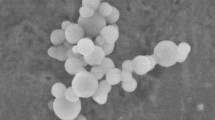Abstract
The electric conductivity is experimentally studied in nanofluids based on water and ethylene glycol containing copper and aluminum particles. Other properties, such as heat conductivity and rheological characteristics, were evaluated as well. The electric conductivity of nanofluids is shown to increase almost linearly with a nanoparticle concentration, but, unlike the heat conductivity, a gain in electric conductivity is due to a decrease in particle size. In this respect, the mechanisms of electric conductivity and heat conductivity are assumed to have the fundamentally different nature.



Similar content being viewed by others
REFERENCES
V. Ya. Rudyak and A. V. Minakov, Current Problems of Micro- and Nanofluidics (Nauka, Novosibirsk, 2016) [in Russian].
E. V. Timofeeva, D. S. Smith, and W. Yu, Nanotecnology 21, 215703 (2010).
V. Ya. Rudyak and S. L. Krasnolutskii, Tech. Phys. 60, 798 (2015).
D. K. Devendiran and V. A. Amirtham, Renewable Sustainable Energy Rev. 60, 21 (2016).
P. K. Das, N. Islam, A. K. Santra, and R. Ganguly, J. Mol. Liq. 237, 304 (2017).
V. Rudyak and A. V. Minakov, Eur. Phys. J. E 41, 15 (2018).
V. Ya. Rudyak and S. L. Krasnolutskii, Tech. Phys. 62, 1456 (2017).
M. I. Pryazhnikov, A. V. Minakov, V. Rudyak, and D. V. Guzei, Int. J. Heat Mass Transfer 104, 1275 (2017).
J. M. Munyalo and X. Zhang, J. Mol. Liq. 265, 77 (2018).
A. Einstein, Ann. Phys. 19, 289 (1906).
G. K. Batchelor, J. Fluid Mech. 83, 97 (1977).
J. C. Maxwell, A Treatise on Electricity and Magnetism (Clarendon, Oxford, 1881).
M. Dong, L. P. Shen, H. Wang, H. B. Wang, and J. Miao, J. Nanomater. 2013, 842963 (2013).
K. G. Kalpana Sarojini, S. V. Manoj, P. K. Singh, and T. Predeep, Coll. Surf., A 417, 39 (2013).
S. Brunauer, P. H. Emmett, and E. Teller, J. Am. Chem. Soc. 60, 309 (1938).
A. V. Minakov, V. Ya. Rudyak, D. V. Guzei, M. I. Pryazhnikov, and A. S. Lobasov, J. Eng. Phys. Thermophys. 88 (1), 149 (2015).
V. Ya. Rudyak, A. A. Belkin, E. A. Tomilina, and V. V. Egorov, Def. Diff. Forum 273–276, 566 (2008).
H. Tabuteau, F. K. Oppong, J. R. de Bruyn, and P. Coussot, Europhys. Lett. 78, 68007 (2007).
Author information
Authors and Affiliations
Corresponding author
Additional information
Translated by O. Maslova
Rights and permissions
About this article
Cite this article
Rudyak, V.Y., Minakov, A.V. & Pryazhnikov, M.I. The Electric Conductivity of Nanofluids with Metal Particles. Tech. Phys. Lett. 45, 457–460 (2019). https://doi.org/10.1134/S1063785019050134
Received:
Revised:
Accepted:
Published:
Issue Date:
DOI: https://doi.org/10.1134/S1063785019050134




